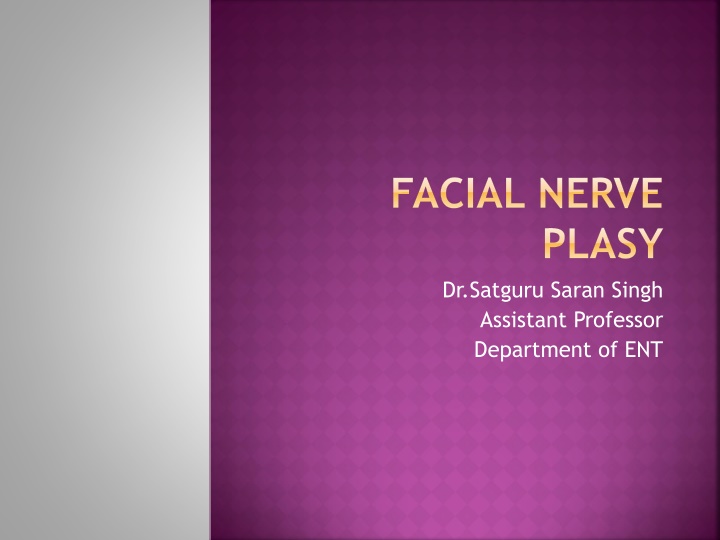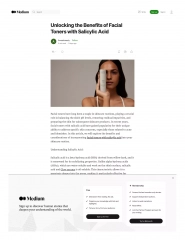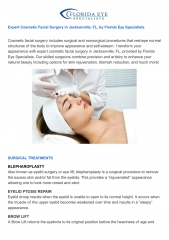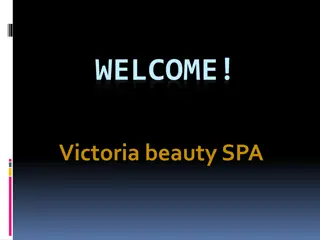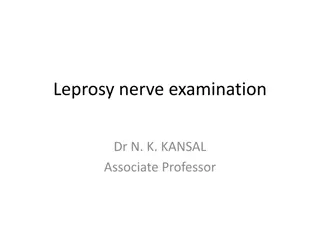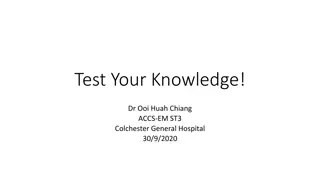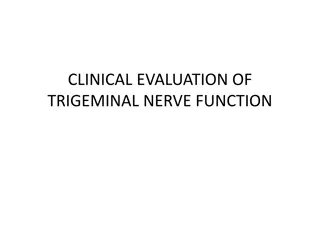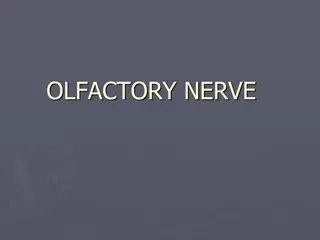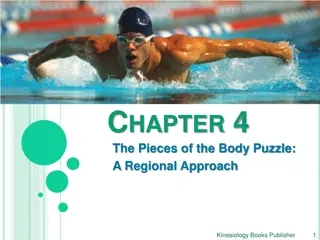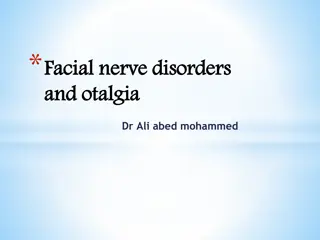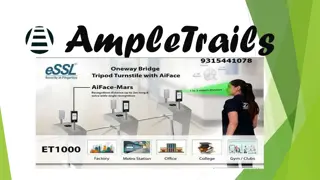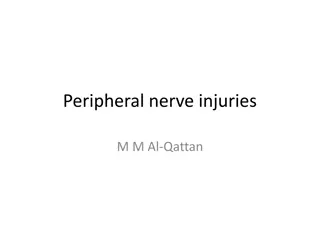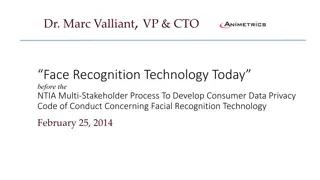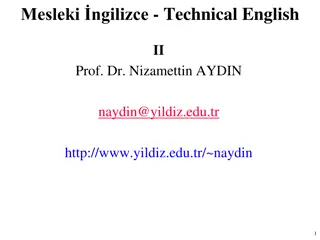FACIAL NERVE PLASY
Facial nerve palsy can lead to various symptoms affecting facial expression, taste sensation, and general sensory functions. This condition involves motor and sensory roots, as well as intracranial, intratemporal, and extracranial components. Detailed knowledge of the intricate pathways and segments involved is crucial for diagnosis and treatment by ENT specialists.
Download Presentation

Please find below an Image/Link to download the presentation.
The content on the website is provided AS IS for your information and personal use only. It may not be sold, licensed, or shared on other websites without obtaining consent from the author.If you encounter any issues during the download, it is possible that the publisher has removed the file from their server.
You are allowed to download the files provided on this website for personal or commercial use, subject to the condition that they are used lawfully. All files are the property of their respective owners.
The content on the website is provided AS IS for your information and personal use only. It may not be sold, licensed, or shared on other websites without obtaining consent from the author.
E N D
Presentation Transcript
FACIAL NERVE PLASY Dr.Satguru Saran Singh Assistant Professor Department of ENT
Pons to parotid Mixed nerve sensory root (nerve of wrisberg)
Special visceral efferents-motor root General visceral efferent secretomotor fibres to lacrimal ,submandiblar ,sublingual glands & small secretory glands in nasal mucosa & palate Special visceral afferent taste from ant 2/3 rd tongue via chorda tympani ,soft & hard palate via greater superficial petrosal nerve General somatic afferents general sensation from concha,postero-sup part of external canal & tympanic memb
Intracranial Intratemporal Extracranial
INTRACRANIAL Intracranial part From pons to Internal Acostic meatus 15-17 mm
INTRATEMPORAL FRM IAM TO STYLOMASTOID FORAMEN Meatal segment 8-10 mm ,within IAM Labyrinthine segment 4 mm fundus of meatus to geniclate ganglion shortest segment Narrowest 0.61- 0.68 mm Tympanic segment 11mm frm GG to just above pyramidal eminence Mastoid / vertical segment 13 mm Frm pyramid to Stylomastoid foramen
EXTRACRANIAL Frm stylomastoid foramen to peripheral branches
BRANCHES Greater superficial petrosal nerve frm GG & carries secretomotor fibres to lacrimal gland & glands of nasal mucosa and palate Nerve to stapedius Arises at level of 2nd genu & supplies stapedius muscle Chorda tympani middle of vertical segment , passes btw incus & neck of malleus & leaves thru petrotympanic fissure. it carries secretomotor fibres to submandibular ,sublingual glands ,brings taste from ant 2/3rds of tonge
Muscular branches stylohyoid & post belly of digastric Peripheral branches Upper- temperofacial Lower-cervicofacial Temporal Zygomatic Buccal Marginal mandiblar cervical
BLOOD SUPPLY Anteroinf cerebellar artery - CP angle Labyrinthine artery IAC Superficial petrosal artery GG Stylomastoid artery mastoid & tympanic segment
Cartilaginous pointer nerve lies 1 cm deep & slightly anterior & inf to pointer. Tympanomastoid suture Nerve lies 6-8 mm deep to suture. Styloid process nerve crosses lateral to styloid process. Posterior belly of digastric nerve lies between it & styloid process.
ELECTRODIAGNOSTIC TESTS Minimal nerve excitabilty tests diff btw 2 sides exceeds 3.5 amp ,test + for degeneration 48- 72 hr . Maximal stimulation test equal , decreased ,absent Decreased /absent degeneration Electroneuronography degeneration of 90% occuring in 1st14 days poorer prognosis Electromyography motor activity of facial muscles. Fibrillation potentials spont invol action potentials in a denervated muscle.(14-21 after denervation ) Polyphasic reinnervation -6-12 wks prior to clinical evidence
Central brain abscess pontine gliomas polio multiple sclerosis Intracranial part (CP angle) Acoustic neuroma meningioma cong cholesteastoma metastatic carcinoma meningitis
Intratemporal part idiopathic-bells palsy - melkersson syndrome Infectious-asom,csom,herpes zoster otics,MOE Trauma surgical :mastoidectomy & stapedectomy Accidental: fractures of temporal bone Neoplasms- malignancies of ext & middle ear,glomus tmr,facial nerve neuroma,mets to temporal bone
Extracranial malignancy of parotid,surgery of parotid ,accidental injury in parotid,neonatal facial injury (obstetrical forceps ) Systemic diseases DM , hypothyroidis,uraemia,polyarteritis nodosa,wegeners granulomatosis ,sarcoidosis,leprosy,lekemia,demyelinating disease
BELLS PALSY 60-75% of facial paralysis Idiopathic , peripheral facial paralysis or paresis of acute onset. Equal sexes affected Any age grp maybe affected Postive family history -6-8 % Risk is more in DM ,pregnant women
AETIOLOGY Viral infections HSV ,HZ,EBV Vascular ischemia pri cold,emotional stress sec result of pri ischaemia Hereditary Autoimmune disorder
DIAGNOSIS By exclusion History Ent examination X ray studies Blood sugar Serology Nerve excitabilty tests Topodiagnostic tests
GENERAL Reassurance Analgesics Eye care physiotherapy
MEDICAL Steroids prednisolone 1mg/kg Surgical - nerve decompression vertical & tympanic segmnent Prognosis 85-90% recover fully
MELKERSSON SYNDROME Idiopathic Triad - facial paralysis, lip swelling ,fissured tonge recurrent
Bells palsy Melkersson syndrome Diabetes Sarcoidosis Tumours Recurrent palsy on same side tmrs in 30 % Gillain barre syndrome Sarcoidosis Sickle cell disease Acute leukemia Bulbar palsy Leprosy Systemic diseases Recurrent facial palsy Bilateral facial palsy
RAMSAY HUNT SYNDROME/HERPES ZOSTER OTICUS Facial palsy Vesicular rash eac & pinna Anaesthesia of face , giddiness
UMN- opp side lower half,wrinkling +,invol emotional movements,tone of facial muscles + Nucleus 6thcn palsy CP angle vestibular+ auditory defects,V,IX,X,XI CN Bony canal frm IAM to SMF topodiagnostic tests
SCHIRMER TEST Lesion proximal to GG - secretomotor fibres to lacrimal gland at the GG via GSPN Filter paper no.41 whatman 5mm wide 35 mm length < 10 mm after 5 mins - abnl
STAPEDIAL REFLEX Lost in lesions above n. to stapedius
TASTE TEST Lesion above chorda tympani
SUBMANDIBULAR SALIVARY FLOW TEST decreased saivation Lesion above chorda tymapani
COMPLICATIONS Incomplete recovery Exposure keratitis Synkinesis ( mass movements ) cross innervation Contractures Psychological & social problems
